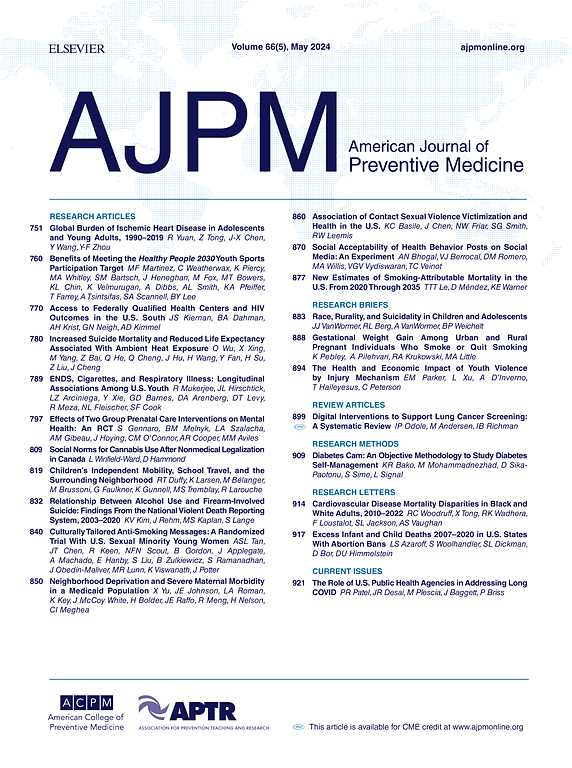减少处方阿片类药物剂量后按性别和年龄划分的不良事件风险。
IF 4.5
2区 医学
Q1 MEDICINE, GENERAL & INTERNAL
引用次数: 0
摘要
处方阿片类药物剂量减少可增加长期阿片类药物治疗非癌性疼痛的患者不良事件的风险。需要证据表明风险是否因年龄或性别而异,以支持量身定制的临床决策。方法:2024年,对8个美国医疗保健系统进行了一项观察性队列研究的二次分析,分析了2012年1月1日至2018年12月31日期间阿片类药物处方登记处(不包括丁丙诺啡处方)的电子健康记录和claims数据,包括稳定使用阿片类药物处方并随后有≥2个月减量期的成年人(n=60,040),共产生600,234个减量期作为分析样本。结果:在600,234个剂量减少期中,346,733个为女性,女性的平均年龄为57.5 [SD=13.2]岁,男性为56.7 [SD=12.1]岁。减量水平与潜在不良事件之间的关联在性别上没有显著差异,但在急诊科就诊的年龄上存在差异:40-64岁和≥65岁的患者减量30岁。结论:40岁以下的患者可能受益于减量后一个月内更密切的监测,因为他们的急诊科就诊几率更高。本文章由计算机程序翻译,如有差异,请以英文原文为准。
Risks for Adverse Events by Sex and Age After Prescription Opioid Dose Reduction
Introduction
Prescription opioid dose reductions can raise the risk of adverse events for patients on long-term opioid therapy for noncancer pain. Evidence on whether risks differ by age or sex is needed to support tailored clinical decision-making.
Methods
In 2024, a secondary analysis of an observational cohort study was conducted across 8 U.S. healthcare systems analyzing electronic health records and claims data from a prescription opioid registry (excluding buprenorphine prescriptions) between January 1, 2012, and December 31, 2018, including adults with stable prescription opioid use and a subsequent ≥2-month dose reduction period (n=60,040), yielding 600,234 dose reduction periods as the analytic sample.
Differences in the association between dose reduction level (1% to <15%, 15% to <30%, 30% to <100%, and 100% from baseline) and potential adverse events (emergency department visits, opioid overdose, all-cause mortality, and benzodiazepine prescription fills) in the month after dose reduction by sex and age group were examined by including interaction terms in logistic regression models.
Results
Of the 600,234 dose reduction periods, 346,733 were among women, with a mean age of 57.5 (SD=13.2) years for women and 56.7 (SD=12.1) years for men. Associations between dose reduction levels and potential adverse events did not differ significantly by sex, but differed by age for emergency department visits: patients aged 40–64 and ≥65 years with dose reductions of 30% to <100% had lower odds than those aged 19–39 years (adjusted ratio of OR=0.87, CI=0.80, 0.96; adjusted ratio of OR=0.82, CI=0.74, 0.91, respectively).
Conclusions
Patients aged <40 years may benefit from closer monitoring in the month after dose reduction, given their higher odds of an emergency department visit.
求助全文
通过发布文献求助,成功后即可免费获取论文全文。
去求助
来源期刊

American Journal of Preventive Medicine
医学-公共卫生、环境卫生与职业卫生
CiteScore
8.60
自引率
1.80%
发文量
395
审稿时长
32 days
期刊介绍:
The American Journal of Preventive Medicine is the official journal of the American College of Preventive Medicine and the Association for Prevention Teaching and Research. It publishes articles in the areas of prevention research, teaching, practice and policy. Original research is published on interventions aimed at the prevention of chronic and acute disease and the promotion of individual and community health.
Of particular emphasis are papers that address the primary and secondary prevention of important clinical, behavioral and public health issues such as injury and violence, infectious disease, women''s health, smoking, sedentary behaviors and physical activity, nutrition, diabetes, obesity, and substance use disorders. Papers also address educational initiatives aimed at improving the ability of health professionals to provide effective clinical prevention and public health services. Papers on health services research pertinent to prevention and public health are also published. The journal also publishes official policy statements from the two co-sponsoring organizations, review articles, media reviews, and editorials. Finally, the journal periodically publishes supplements and special theme issues devoted to areas of current interest to the prevention community.
 求助内容:
求助内容: 应助结果提醒方式:
应助结果提醒方式:


